SFSU Project: Stakeholder Communication & Risk Management Analysis
VerifiedAdded on 2023/06/07
|16
|4463
|365
Case Study
AI Summary
This case study examines the replacement of the Remedy ticketing software with Request Tracker (RT) at Silicon Forest State University (SFSU). It highlights the flaws of the existing system and the need for effective project management. The study delves into stakeholder identification, their roles, and the importance of a stakeholder management plan and communication plan. It emphasizes the advantages and disadvantages of communication plans, including improved communication, risk assessment, and potential increases in costs and complexity. Furthermore, the case study underscores the significance of a risk management plan in identifying, analyzing, and mitigating project risks, ensuring project success. Desklib provides access to similar solved assignments and study resources for students.

Project Management
1
1
Paraphrase This Document
Need a fresh take? Get an instant paraphrase of this document with our AI Paraphraser
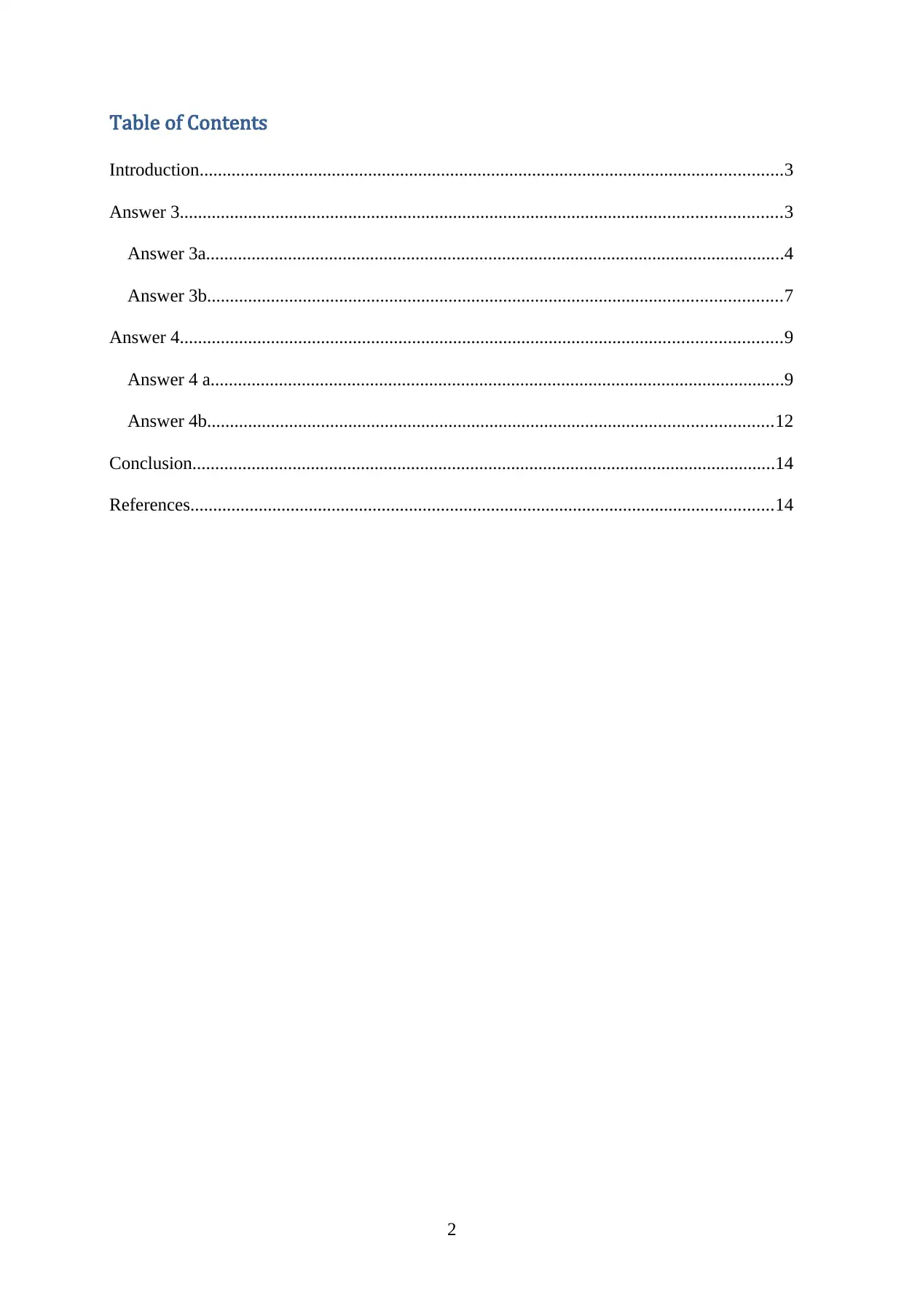
Table of Contents
Introduction................................................................................................................................3
Answer 3....................................................................................................................................3
Answer 3a...............................................................................................................................4
Answer 3b..............................................................................................................................7
Answer 4....................................................................................................................................9
Answer 4 a..............................................................................................................................9
Answer 4b............................................................................................................................12
Conclusion................................................................................................................................14
References................................................................................................................................14
2
Introduction................................................................................................................................3
Answer 3....................................................................................................................................3
Answer 3a...............................................................................................................................4
Answer 3b..............................................................................................................................7
Answer 4....................................................................................................................................9
Answer 4 a..............................................................................................................................9
Answer 4b............................................................................................................................12
Conclusion................................................................................................................................14
References................................................................................................................................14
2
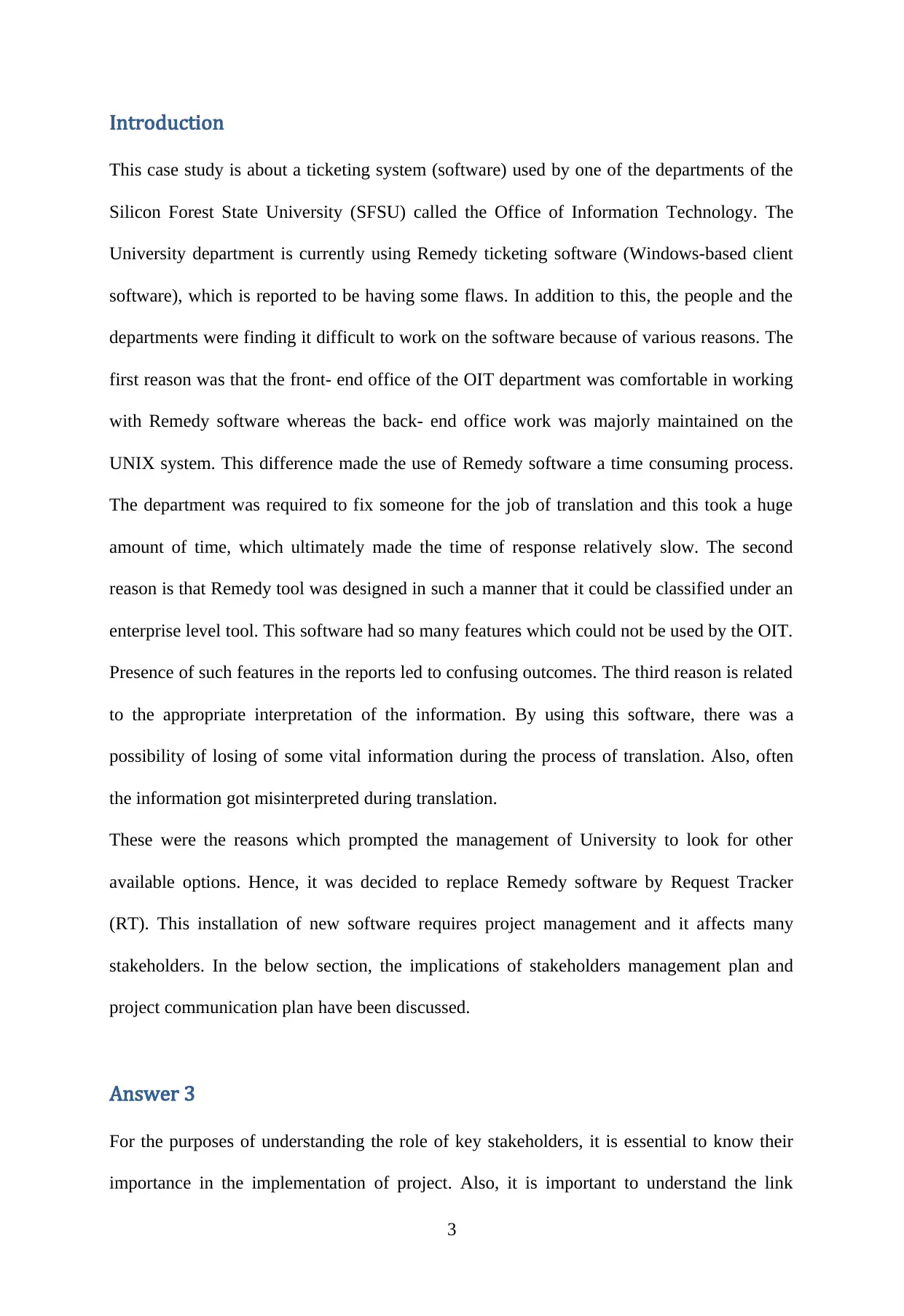
Introduction
This case study is about a ticketing system (software) used by one of the departments of the
Silicon Forest State University (SFSU) called the Office of Information Technology. The
University department is currently using Remedy ticketing software (Windows-based client
software), which is reported to be having some flaws. In addition to this, the people and the
departments were finding it difficult to work on the software because of various reasons. The
first reason was that the front- end office of the OIT department was comfortable in working
with Remedy software whereas the back- end office work was majorly maintained on the
UNIX system. This difference made the use of Remedy software a time consuming process.
The department was required to fix someone for the job of translation and this took a huge
amount of time, which ultimately made the time of response relatively slow. The second
reason is that Remedy tool was designed in such a manner that it could be classified under an
enterprise level tool. This software had so many features which could not be used by the OIT.
Presence of such features in the reports led to confusing outcomes. The third reason is related
to the appropriate interpretation of the information. By using this software, there was a
possibility of losing of some vital information during the process of translation. Also, often
the information got misinterpreted during translation.
These were the reasons which prompted the management of University to look for other
available options. Hence, it was decided to replace Remedy software by Request Tracker
(RT). This installation of new software requires project management and it affects many
stakeholders. In the below section, the implications of stakeholders management plan and
project communication plan have been discussed.
Answer 3
For the purposes of understanding the role of key stakeholders, it is essential to know their
importance in the implementation of project. Also, it is important to understand the link
3
This case study is about a ticketing system (software) used by one of the departments of the
Silicon Forest State University (SFSU) called the Office of Information Technology. The
University department is currently using Remedy ticketing software (Windows-based client
software), which is reported to be having some flaws. In addition to this, the people and the
departments were finding it difficult to work on the software because of various reasons. The
first reason was that the front- end office of the OIT department was comfortable in working
with Remedy software whereas the back- end office work was majorly maintained on the
UNIX system. This difference made the use of Remedy software a time consuming process.
The department was required to fix someone for the job of translation and this took a huge
amount of time, which ultimately made the time of response relatively slow. The second
reason is that Remedy tool was designed in such a manner that it could be classified under an
enterprise level tool. This software had so many features which could not be used by the OIT.
Presence of such features in the reports led to confusing outcomes. The third reason is related
to the appropriate interpretation of the information. By using this software, there was a
possibility of losing of some vital information during the process of translation. Also, often
the information got misinterpreted during translation.
These were the reasons which prompted the management of University to look for other
available options. Hence, it was decided to replace Remedy software by Request Tracker
(RT). This installation of new software requires project management and it affects many
stakeholders. In the below section, the implications of stakeholders management plan and
project communication plan have been discussed.
Answer 3
For the purposes of understanding the role of key stakeholders, it is essential to know their
importance in the implementation of project. Also, it is important to understand the link
3
⊘ This is a preview!⊘
Do you want full access?
Subscribe today to unlock all pages.

Trusted by 1+ million students worldwide
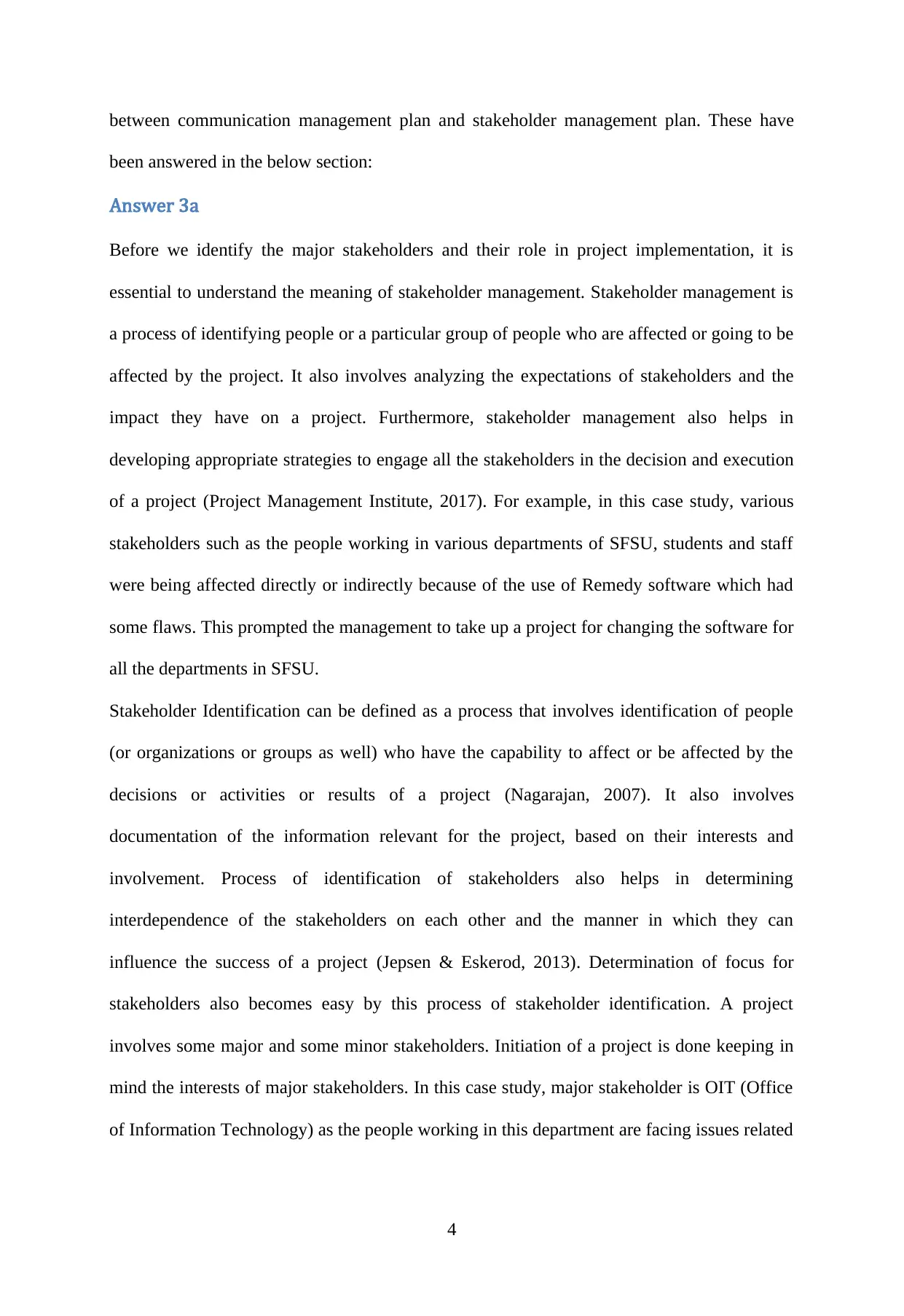
between communication management plan and stakeholder management plan. These have
been answered in the below section:
Answer 3a
Before we identify the major stakeholders and their role in project implementation, it is
essential to understand the meaning of stakeholder management. Stakeholder management is
a process of identifying people or a particular group of people who are affected or going to be
affected by the project. It also involves analyzing the expectations of stakeholders and the
impact they have on a project. Furthermore, stakeholder management also helps in
developing appropriate strategies to engage all the stakeholders in the decision and execution
of a project (Project Management Institute, 2017). For example, in this case study, various
stakeholders such as the people working in various departments of SFSU, students and staff
were being affected directly or indirectly because of the use of Remedy software which had
some flaws. This prompted the management to take up a project for changing the software for
all the departments in SFSU.
Stakeholder Identification can be defined as a process that involves identification of people
(or organizations or groups as well) who have the capability to affect or be affected by the
decisions or activities or results of a project (Nagarajan, 2007). It also involves
documentation of the information relevant for the project, based on their interests and
involvement. Process of identification of stakeholders also helps in determining
interdependence of the stakeholders on each other and the manner in which they can
influence the success of a project (Jepsen & Eskerod, 2013). Determination of focus for
stakeholders also becomes easy by this process of stakeholder identification. A project
involves some major and some minor stakeholders. Initiation of a project is done keeping in
mind the interests of major stakeholders. In this case study, major stakeholder is OIT (Office
of Information Technology) as the people working in this department are facing issues related
4
been answered in the below section:
Answer 3a
Before we identify the major stakeholders and their role in project implementation, it is
essential to understand the meaning of stakeholder management. Stakeholder management is
a process of identifying people or a particular group of people who are affected or going to be
affected by the project. It also involves analyzing the expectations of stakeholders and the
impact they have on a project. Furthermore, stakeholder management also helps in
developing appropriate strategies to engage all the stakeholders in the decision and execution
of a project (Project Management Institute, 2017). For example, in this case study, various
stakeholders such as the people working in various departments of SFSU, students and staff
were being affected directly or indirectly because of the use of Remedy software which had
some flaws. This prompted the management to take up a project for changing the software for
all the departments in SFSU.
Stakeholder Identification can be defined as a process that involves identification of people
(or organizations or groups as well) who have the capability to affect or be affected by the
decisions or activities or results of a project (Nagarajan, 2007). It also involves
documentation of the information relevant for the project, based on their interests and
involvement. Process of identification of stakeholders also helps in determining
interdependence of the stakeholders on each other and the manner in which they can
influence the success of a project (Jepsen & Eskerod, 2013). Determination of focus for
stakeholders also becomes easy by this process of stakeholder identification. A project
involves some major and some minor stakeholders. Initiation of a project is done keeping in
mind the interests of major stakeholders. In this case study, major stakeholder is OIT (Office
of Information Technology) as the people working in this department are facing issues related
4
Paraphrase This Document
Need a fresh take? Get an instant paraphrase of this document with our AI Paraphraser
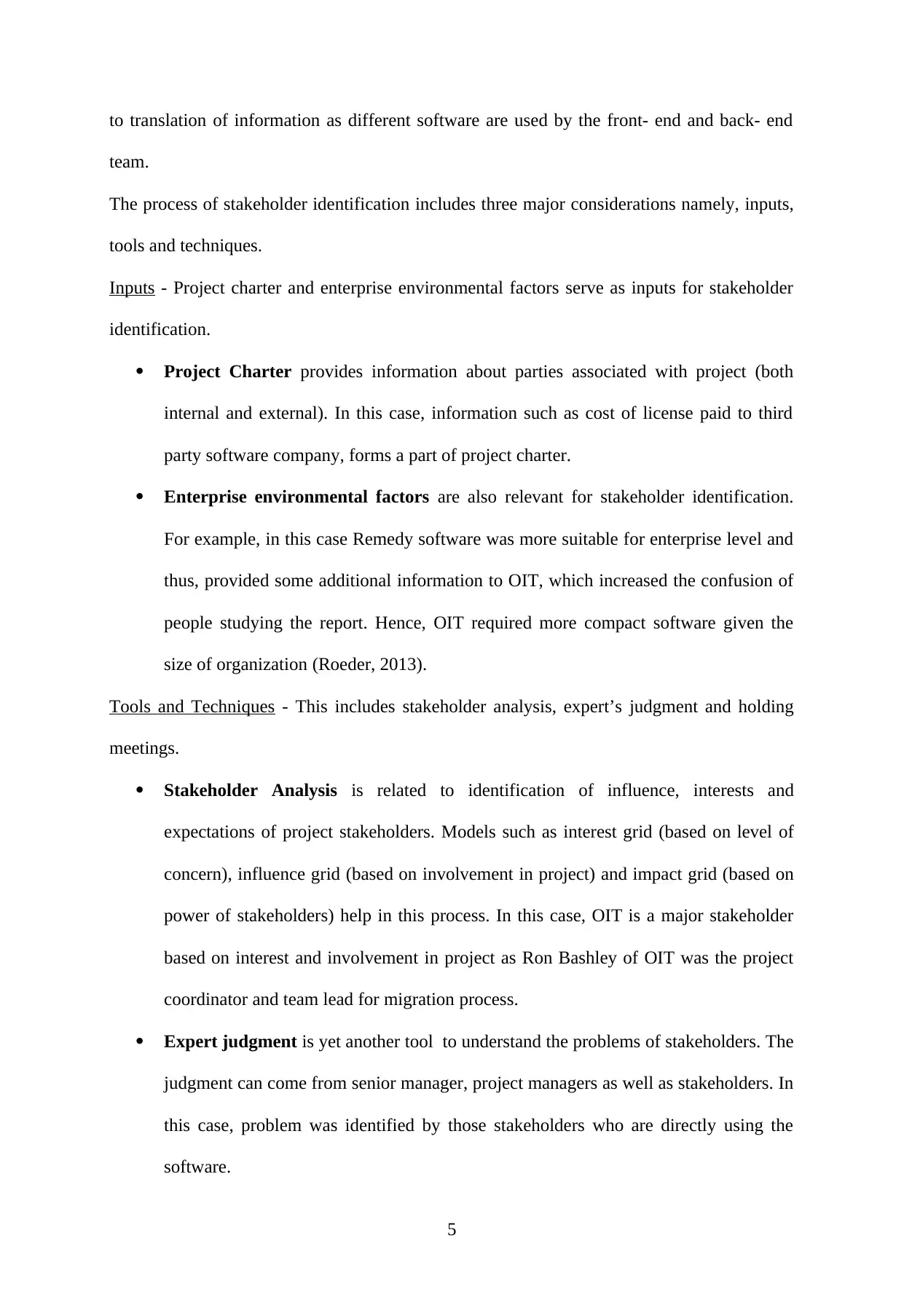
to translation of information as different software are used by the front- end and back- end
team.
The process of stakeholder identification includes three major considerations namely, inputs,
tools and techniques.
Inputs - Project charter and enterprise environmental factors serve as inputs for stakeholder
identification.
Project Charter provides information about parties associated with project (both
internal and external). In this case, information such as cost of license paid to third
party software company, forms a part of project charter.
Enterprise environmental factors are also relevant for stakeholder identification.
For example, in this case Remedy software was more suitable for enterprise level and
thus, provided some additional information to OIT, which increased the confusion of
people studying the report. Hence, OIT required more compact software given the
size of organization (Roeder, 2013).
Tools and Techniques - This includes stakeholder analysis, expert’s judgment and holding
meetings.
Stakeholder Analysis is related to identification of influence, interests and
expectations of project stakeholders. Models such as interest grid (based on level of
concern), influence grid (based on involvement in project) and impact grid (based on
power of stakeholders) help in this process. In this case, OIT is a major stakeholder
based on interest and involvement in project as Ron Bashley of OIT was the project
coordinator and team lead for migration process.
Expert judgment is yet another tool to understand the problems of stakeholders. The
judgment can come from senior manager, project managers as well as stakeholders. In
this case, problem was identified by those stakeholders who are directly using the
software.
5
team.
The process of stakeholder identification includes three major considerations namely, inputs,
tools and techniques.
Inputs - Project charter and enterprise environmental factors serve as inputs for stakeholder
identification.
Project Charter provides information about parties associated with project (both
internal and external). In this case, information such as cost of license paid to third
party software company, forms a part of project charter.
Enterprise environmental factors are also relevant for stakeholder identification.
For example, in this case Remedy software was more suitable for enterprise level and
thus, provided some additional information to OIT, which increased the confusion of
people studying the report. Hence, OIT required more compact software given the
size of organization (Roeder, 2013).
Tools and Techniques - This includes stakeholder analysis, expert’s judgment and holding
meetings.
Stakeholder Analysis is related to identification of influence, interests and
expectations of project stakeholders. Models such as interest grid (based on level of
concern), influence grid (based on involvement in project) and impact grid (based on
power of stakeholders) help in this process. In this case, OIT is a major stakeholder
based on interest and involvement in project as Ron Bashley of OIT was the project
coordinator and team lead for migration process.
Expert judgment is yet another tool to understand the problems of stakeholders. The
judgment can come from senior manager, project managers as well as stakeholders. In
this case, problem was identified by those stakeholders who are directly using the
software.
5
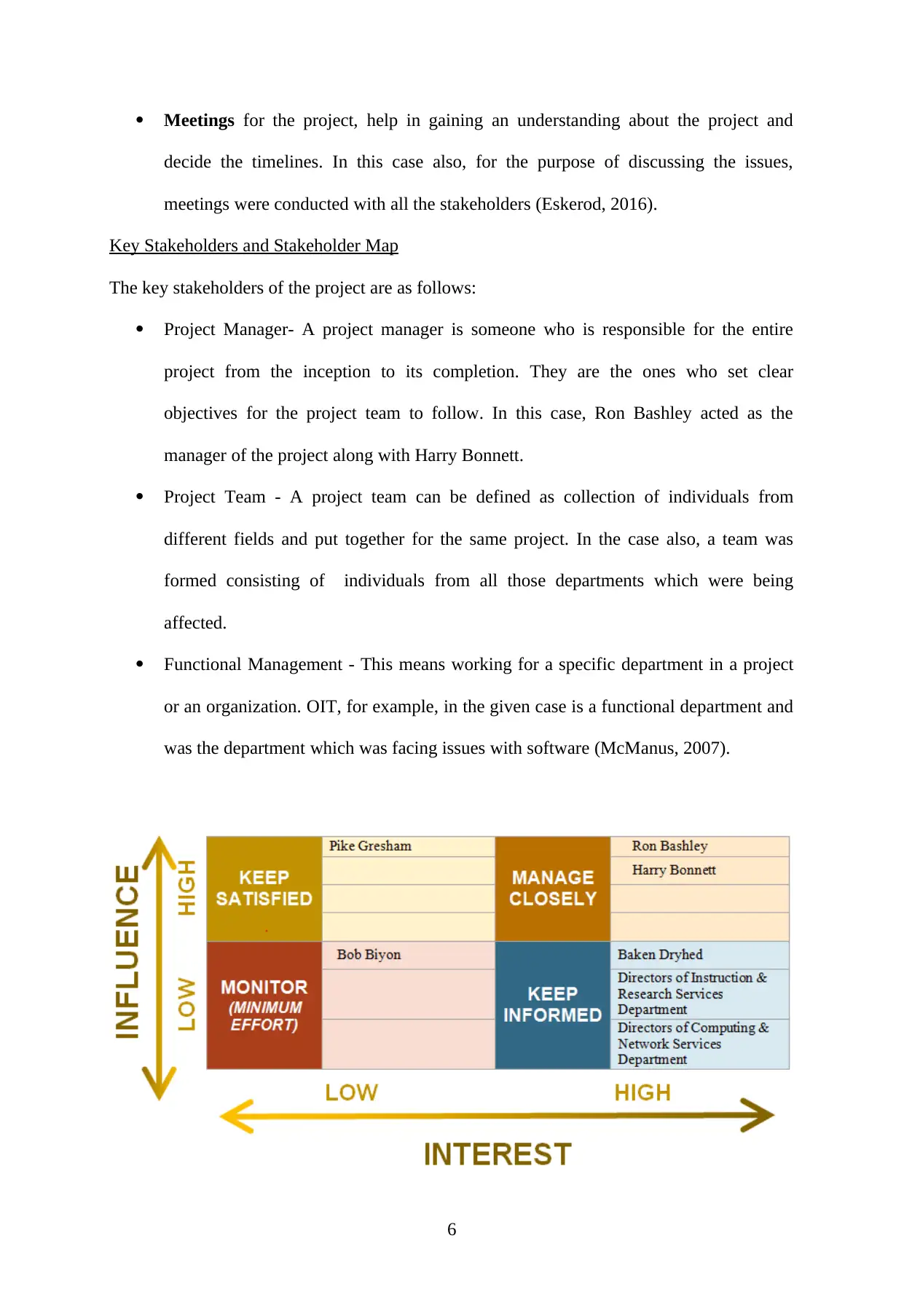
Meetings for the project, help in gaining an understanding about the project and
decide the timelines. In this case also, for the purpose of discussing the issues,
meetings were conducted with all the stakeholders (Eskerod, 2016).
Key Stakeholders and Stakeholder Map
The key stakeholders of the project are as follows:
Project Manager- A project manager is someone who is responsible for the entire
project from the inception to its completion. They are the ones who set clear
objectives for the project team to follow. In this case, Ron Bashley acted as the
manager of the project along with Harry Bonnett.
Project Team - A project team can be defined as collection of individuals from
different fields and put together for the same project. In the case also, a team was
formed consisting of individuals from all those departments which were being
affected.
Functional Management - This means working for a specific department in a project
or an organization. OIT, for example, in the given case is a functional department and
was the department which was facing issues with software (McManus, 2007).
6
decide the timelines. In this case also, for the purpose of discussing the issues,
meetings were conducted with all the stakeholders (Eskerod, 2016).
Key Stakeholders and Stakeholder Map
The key stakeholders of the project are as follows:
Project Manager- A project manager is someone who is responsible for the entire
project from the inception to its completion. They are the ones who set clear
objectives for the project team to follow. In this case, Ron Bashley acted as the
manager of the project along with Harry Bonnett.
Project Team - A project team can be defined as collection of individuals from
different fields and put together for the same project. In the case also, a team was
formed consisting of individuals from all those departments which were being
affected.
Functional Management - This means working for a specific department in a project
or an organization. OIT, for example, in the given case is a functional department and
was the department which was facing issues with software (McManus, 2007).
6
⊘ This is a preview!⊘
Do you want full access?
Subscribe today to unlock all pages.

Trusted by 1+ million students worldwide
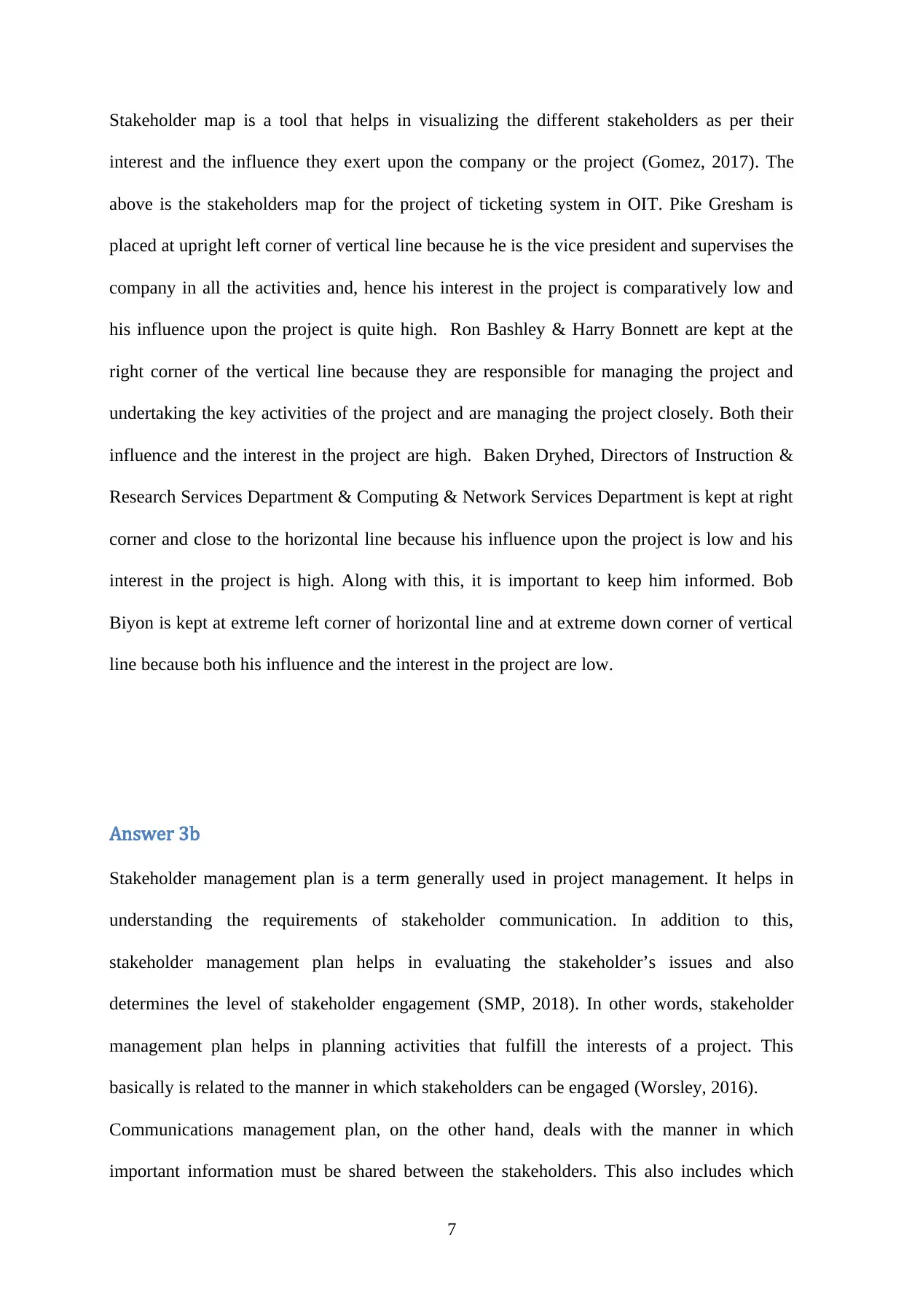
Stakeholder map is a tool that helps in visualizing the different stakeholders as per their
interest and the influence they exert upon the company or the project (Gomez, 2017). The
above is the stakeholders map for the project of ticketing system in OIT. Pike Gresham is
placed at upright left corner of vertical line because he is the vice president and supervises the
company in all the activities and, hence his interest in the project is comparatively low and
his influence upon the project is quite high. Ron Bashley & Harry Bonnett are kept at the
right corner of the vertical line because they are responsible for managing the project and
undertaking the key activities of the project and are managing the project closely. Both their
influence and the interest in the project are high. Baken Dryhed, Directors of Instruction &
Research Services Department & Computing & Network Services Department is kept at right
corner and close to the horizontal line because his influence upon the project is low and his
interest in the project is high. Along with this, it is important to keep him informed. Bob
Biyon is kept at extreme left corner of horizontal line and at extreme down corner of vertical
line because both his influence and the interest in the project are low.
Answer 3b
Stakeholder management plan is a term generally used in project management. It helps in
understanding the requirements of stakeholder communication. In addition to this,
stakeholder management plan helps in evaluating the stakeholder’s issues and also
determines the level of stakeholder engagement (SMP, 2018). In other words, stakeholder
management plan helps in planning activities that fulfill the interests of a project. This
basically is related to the manner in which stakeholders can be engaged (Worsley, 2016).
Communications management plan, on the other hand, deals with the manner in which
important information must be shared between the stakeholders. This also includes which
7
interest and the influence they exert upon the company or the project (Gomez, 2017). The
above is the stakeholders map for the project of ticketing system in OIT. Pike Gresham is
placed at upright left corner of vertical line because he is the vice president and supervises the
company in all the activities and, hence his interest in the project is comparatively low and
his influence upon the project is quite high. Ron Bashley & Harry Bonnett are kept at the
right corner of the vertical line because they are responsible for managing the project and
undertaking the key activities of the project and are managing the project closely. Both their
influence and the interest in the project are high. Baken Dryhed, Directors of Instruction &
Research Services Department & Computing & Network Services Department is kept at right
corner and close to the horizontal line because his influence upon the project is low and his
interest in the project is high. Along with this, it is important to keep him informed. Bob
Biyon is kept at extreme left corner of horizontal line and at extreme down corner of vertical
line because both his influence and the interest in the project are low.
Answer 3b
Stakeholder management plan is a term generally used in project management. It helps in
understanding the requirements of stakeholder communication. In addition to this,
stakeholder management plan helps in evaluating the stakeholder’s issues and also
determines the level of stakeholder engagement (SMP, 2018). In other words, stakeholder
management plan helps in planning activities that fulfill the interests of a project. This
basically is related to the manner in which stakeholders can be engaged (Worsley, 2016).
Communications management plan, on the other hand, deals with the manner in which
important information must be shared between the stakeholders. This also includes which
7
Paraphrase This Document
Need a fresh take? Get an instant paraphrase of this document with our AI Paraphraser
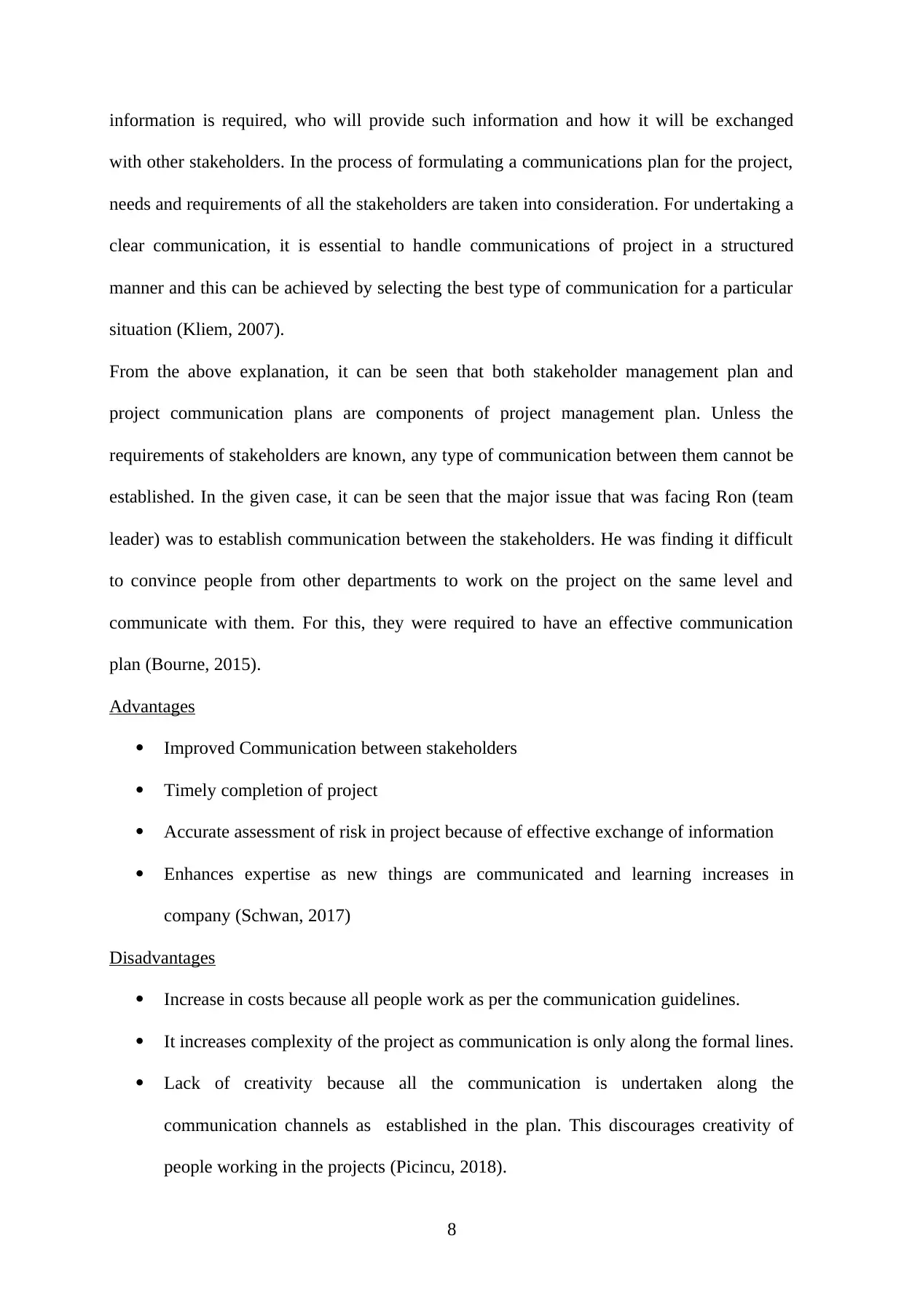
information is required, who will provide such information and how it will be exchanged
with other stakeholders. In the process of formulating a communications plan for the project,
needs and requirements of all the stakeholders are taken into consideration. For undertaking a
clear communication, it is essential to handle communications of project in a structured
manner and this can be achieved by selecting the best type of communication for a particular
situation (Kliem, 2007).
From the above explanation, it can be seen that both stakeholder management plan and
project communication plans are components of project management plan. Unless the
requirements of stakeholders are known, any type of communication between them cannot be
established. In the given case, it can be seen that the major issue that was facing Ron (team
leader) was to establish communication between the stakeholders. He was finding it difficult
to convince people from other departments to work on the project on the same level and
communicate with them. For this, they were required to have an effective communication
plan (Bourne, 2015).
Advantages
Improved Communication between stakeholders
Timely completion of project
Accurate assessment of risk in project because of effective exchange of information
Enhances expertise as new things are communicated and learning increases in
company (Schwan, 2017)
Disadvantages
Increase in costs because all people work as per the communication guidelines.
It increases complexity of the project as communication is only along the formal lines.
Lack of creativity because all the communication is undertaken along the
communication channels as established in the plan. This discourages creativity of
people working in the projects (Picincu, 2018).
8
with other stakeholders. In the process of formulating a communications plan for the project,
needs and requirements of all the stakeholders are taken into consideration. For undertaking a
clear communication, it is essential to handle communications of project in a structured
manner and this can be achieved by selecting the best type of communication for a particular
situation (Kliem, 2007).
From the above explanation, it can be seen that both stakeholder management plan and
project communication plans are components of project management plan. Unless the
requirements of stakeholders are known, any type of communication between them cannot be
established. In the given case, it can be seen that the major issue that was facing Ron (team
leader) was to establish communication between the stakeholders. He was finding it difficult
to convince people from other departments to work on the project on the same level and
communicate with them. For this, they were required to have an effective communication
plan (Bourne, 2015).
Advantages
Improved Communication between stakeholders
Timely completion of project
Accurate assessment of risk in project because of effective exchange of information
Enhances expertise as new things are communicated and learning increases in
company (Schwan, 2017)
Disadvantages
Increase in costs because all people work as per the communication guidelines.
It increases complexity of the project as communication is only along the formal lines.
Lack of creativity because all the communication is undertaken along the
communication channels as established in the plan. This discourages creativity of
people working in the projects (Picincu, 2018).
8
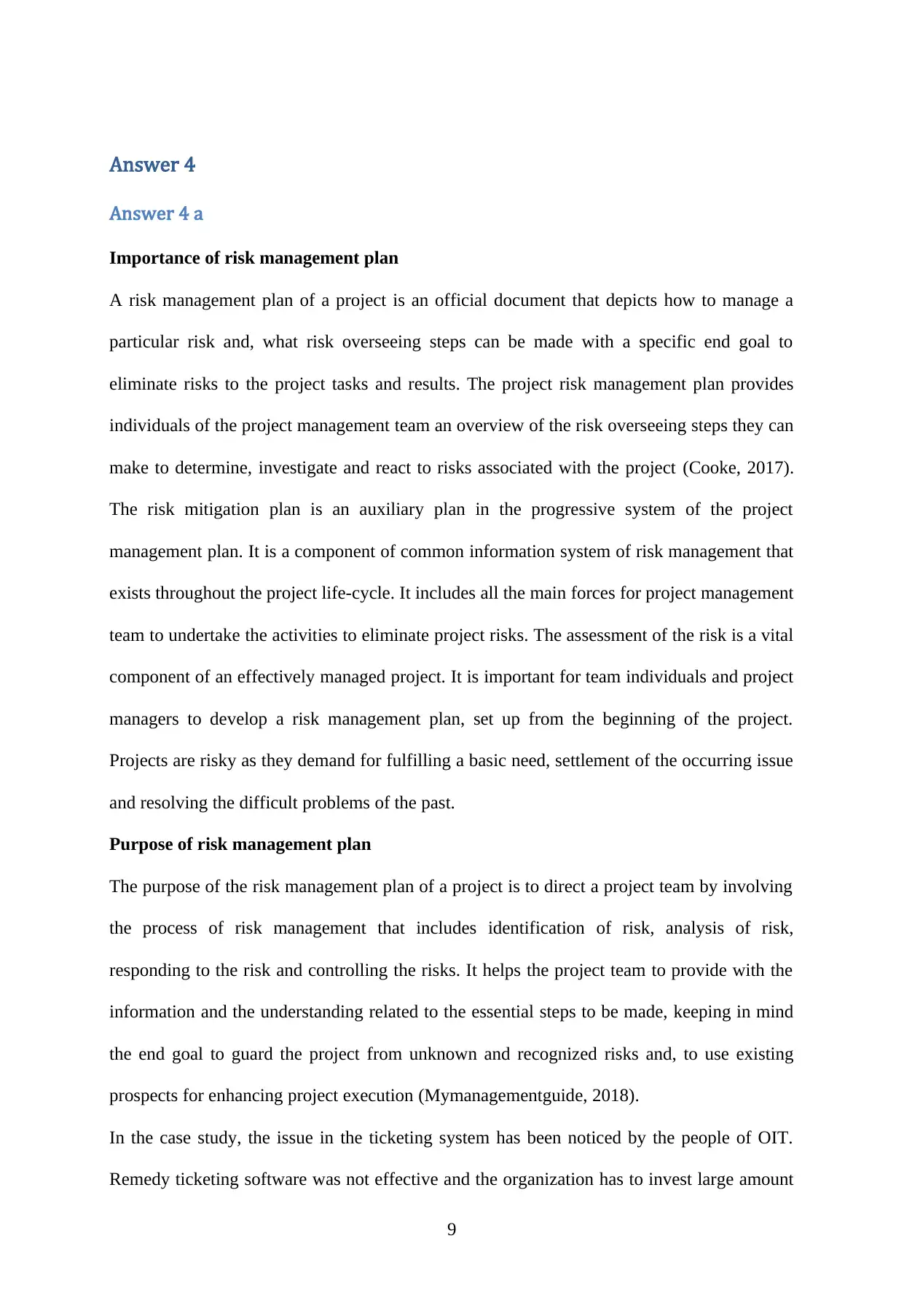
Answer 4
Answer 4 a
Importance of risk management plan
A risk management plan of a project is an official document that depicts how to manage a
particular risk and, what risk overseeing steps can be made with a specific end goal to
eliminate risks to the project tasks and results. The project risk management plan provides
individuals of the project management team an overview of the risk overseeing steps they can
make to determine, investigate and react to risks associated with the project (Cooke, 2017).
The risk mitigation plan is an auxiliary plan in the progressive system of the project
management plan. It is a component of common information system of risk management that
exists throughout the project life-cycle. It includes all the main forces for project management
team to undertake the activities to eliminate project risks. The assessment of the risk is a vital
component of an effectively managed project. It is important for team individuals and project
managers to develop a risk management plan, set up from the beginning of the project.
Projects are risky as they demand for fulfilling a basic need, settlement of the occurring issue
and resolving the difficult problems of the past.
Purpose of risk management plan
The purpose of the risk management plan of a project is to direct a project team by involving
the process of risk management that includes identification of risk, analysis of risk,
responding to the risk and controlling the risks. It helps the project team to provide with the
information and the understanding related to the essential steps to be made, keeping in mind
the end goal to guard the project from unknown and recognized risks and, to use existing
prospects for enhancing project execution (Mymanagementguide, 2018).
In the case study, the issue in the ticketing system has been noticed by the people of OIT.
Remedy ticketing software was not effective and the organization has to invest large amount
9
Answer 4 a
Importance of risk management plan
A risk management plan of a project is an official document that depicts how to manage a
particular risk and, what risk overseeing steps can be made with a specific end goal to
eliminate risks to the project tasks and results. The project risk management plan provides
individuals of the project management team an overview of the risk overseeing steps they can
make to determine, investigate and react to risks associated with the project (Cooke, 2017).
The risk mitigation plan is an auxiliary plan in the progressive system of the project
management plan. It is a component of common information system of risk management that
exists throughout the project life-cycle. It includes all the main forces for project management
team to undertake the activities to eliminate project risks. The assessment of the risk is a vital
component of an effectively managed project. It is important for team individuals and project
managers to develop a risk management plan, set up from the beginning of the project.
Projects are risky as they demand for fulfilling a basic need, settlement of the occurring issue
and resolving the difficult problems of the past.
Purpose of risk management plan
The purpose of the risk management plan of a project is to direct a project team by involving
the process of risk management that includes identification of risk, analysis of risk,
responding to the risk and controlling the risks. It helps the project team to provide with the
information and the understanding related to the essential steps to be made, keeping in mind
the end goal to guard the project from unknown and recognized risks and, to use existing
prospects for enhancing project execution (Mymanagementguide, 2018).
In the case study, the issue in the ticketing system has been noticed by the people of OIT.
Remedy ticketing software was not effective and the organization has to invest large amount
9
⊘ This is a preview!⊘
Do you want full access?
Subscribe today to unlock all pages.

Trusted by 1+ million students worldwide
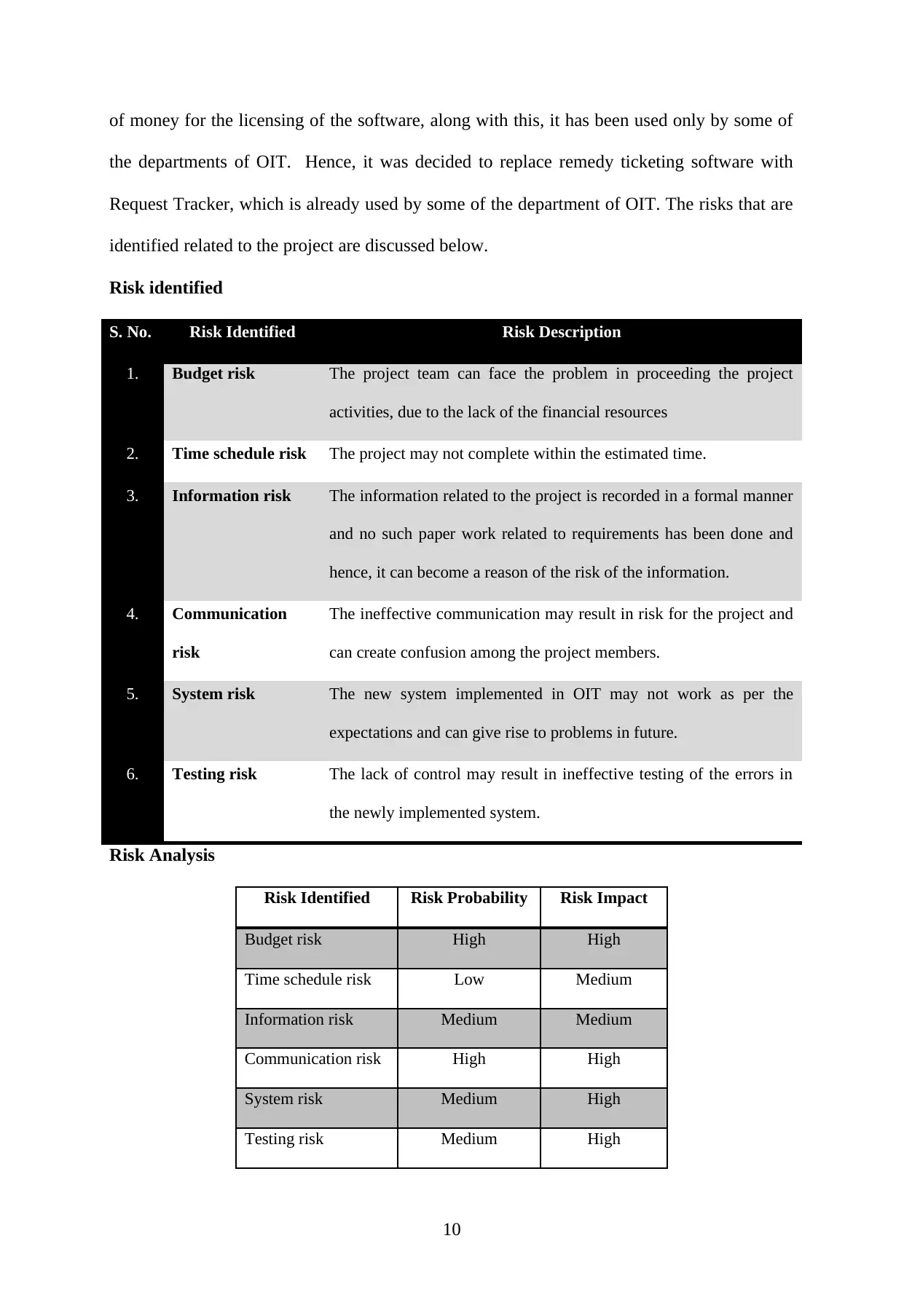
of money for the licensing of the software, along with this, it has been used only by some of
the departments of OIT. Hence, it was decided to replace remedy ticketing software with
Request Tracker, which is already used by some of the department of OIT. The risks that are
identified related to the project are discussed below.
Risk identified
S. No. Risk Identified Risk Description
1. Budget risk The project team can face the problem in proceeding the project
activities, due to the lack of the financial resources
2. Time schedule risk The project may not complete within the estimated time.
3. Information risk The information related to the project is recorded in a formal manner
and no such paper work related to requirements has been done and
hence, it can become a reason of the risk of the information.
4. Communication
risk
The ineffective communication may result in risk for the project and
can create confusion among the project members.
5. System risk The new system implemented in OIT may not work as per the
expectations and can give rise to problems in future.
6. Testing risk The lack of control may result in ineffective testing of the errors in
the newly implemented system.
Risk Analysis
Risk Identified Risk Probability Risk Impact
Budget risk High High
Time schedule risk Low Medium
Information risk Medium Medium
Communication risk High High
System risk Medium High
Testing risk Medium High
10
the departments of OIT. Hence, it was decided to replace remedy ticketing software with
Request Tracker, which is already used by some of the department of OIT. The risks that are
identified related to the project are discussed below.
Risk identified
S. No. Risk Identified Risk Description
1. Budget risk The project team can face the problem in proceeding the project
activities, due to the lack of the financial resources
2. Time schedule risk The project may not complete within the estimated time.
3. Information risk The information related to the project is recorded in a formal manner
and no such paper work related to requirements has been done and
hence, it can become a reason of the risk of the information.
4. Communication
risk
The ineffective communication may result in risk for the project and
can create confusion among the project members.
5. System risk The new system implemented in OIT may not work as per the
expectations and can give rise to problems in future.
6. Testing risk The lack of control may result in ineffective testing of the errors in
the newly implemented system.
Risk Analysis
Risk Identified Risk Probability Risk Impact
Budget risk High High
Time schedule risk Low Medium
Information risk Medium Medium
Communication risk High High
System risk Medium High
Testing risk Medium High
10
Paraphrase This Document
Need a fresh take? Get an instant paraphrase of this document with our AI Paraphraser
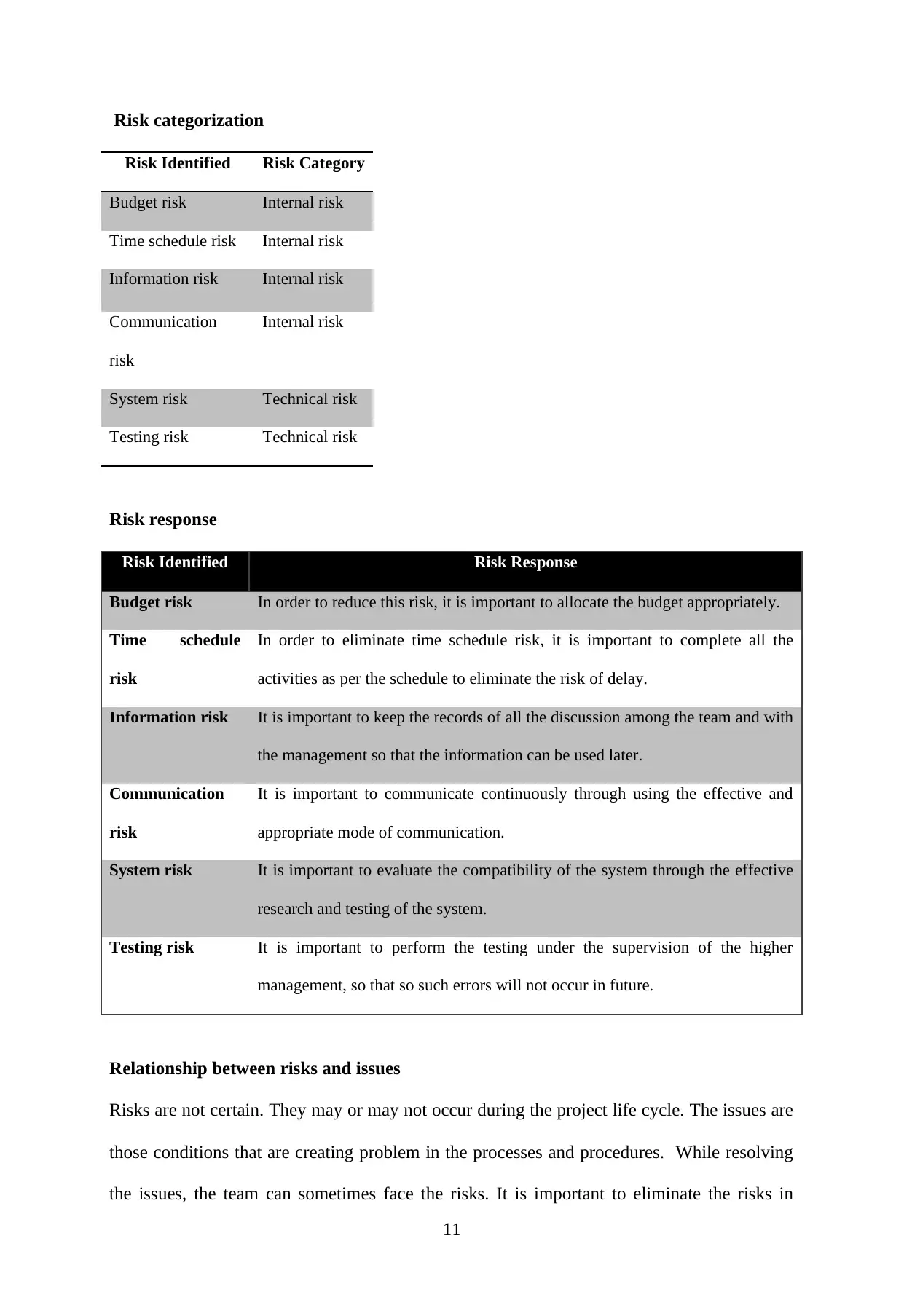
Risk categorization
Risk Identified Risk Category
Budget risk Internal risk
Time schedule risk Internal risk
Information risk Internal risk
Communication
risk
Internal risk
System risk Technical risk
Testing risk Technical risk
Risk response
Risk Identified Risk Response
Budget risk In order to reduce this risk, it is important to allocate the budget appropriately.
Time schedule
risk
In order to eliminate time schedule risk, it is important to complete all the
activities as per the schedule to eliminate the risk of delay.
Information risk It is important to keep the records of all the discussion among the team and with
the management so that the information can be used later.
Communication
risk
It is important to communicate continuously through using the effective and
appropriate mode of communication.
System risk It is important to evaluate the compatibility of the system through the effective
research and testing of the system.
Testing risk It is important to perform the testing under the supervision of the higher
management, so that so such errors will not occur in future.
Relationship between risks and issues
Risks are not certain. They may or may not occur during the project life cycle. The issues are
those conditions that are creating problem in the processes and procedures. While resolving
the issues, the team can sometimes face the risks. It is important to eliminate the risks in
11
Risk Identified Risk Category
Budget risk Internal risk
Time schedule risk Internal risk
Information risk Internal risk
Communication
risk
Internal risk
System risk Technical risk
Testing risk Technical risk
Risk response
Risk Identified Risk Response
Budget risk In order to reduce this risk, it is important to allocate the budget appropriately.
Time schedule
risk
In order to eliminate time schedule risk, it is important to complete all the
activities as per the schedule to eliminate the risk of delay.
Information risk It is important to keep the records of all the discussion among the team and with
the management so that the information can be used later.
Communication
risk
It is important to communicate continuously through using the effective and
appropriate mode of communication.
System risk It is important to evaluate the compatibility of the system through the effective
research and testing of the system.
Testing risk It is important to perform the testing under the supervision of the higher
management, so that so such errors will not occur in future.
Relationship between risks and issues
Risks are not certain. They may or may not occur during the project life cycle. The issues are
those conditions that are creating problem in the processes and procedures. While resolving
the issues, the team can sometimes face the risks. It is important to eliminate the risks in
11
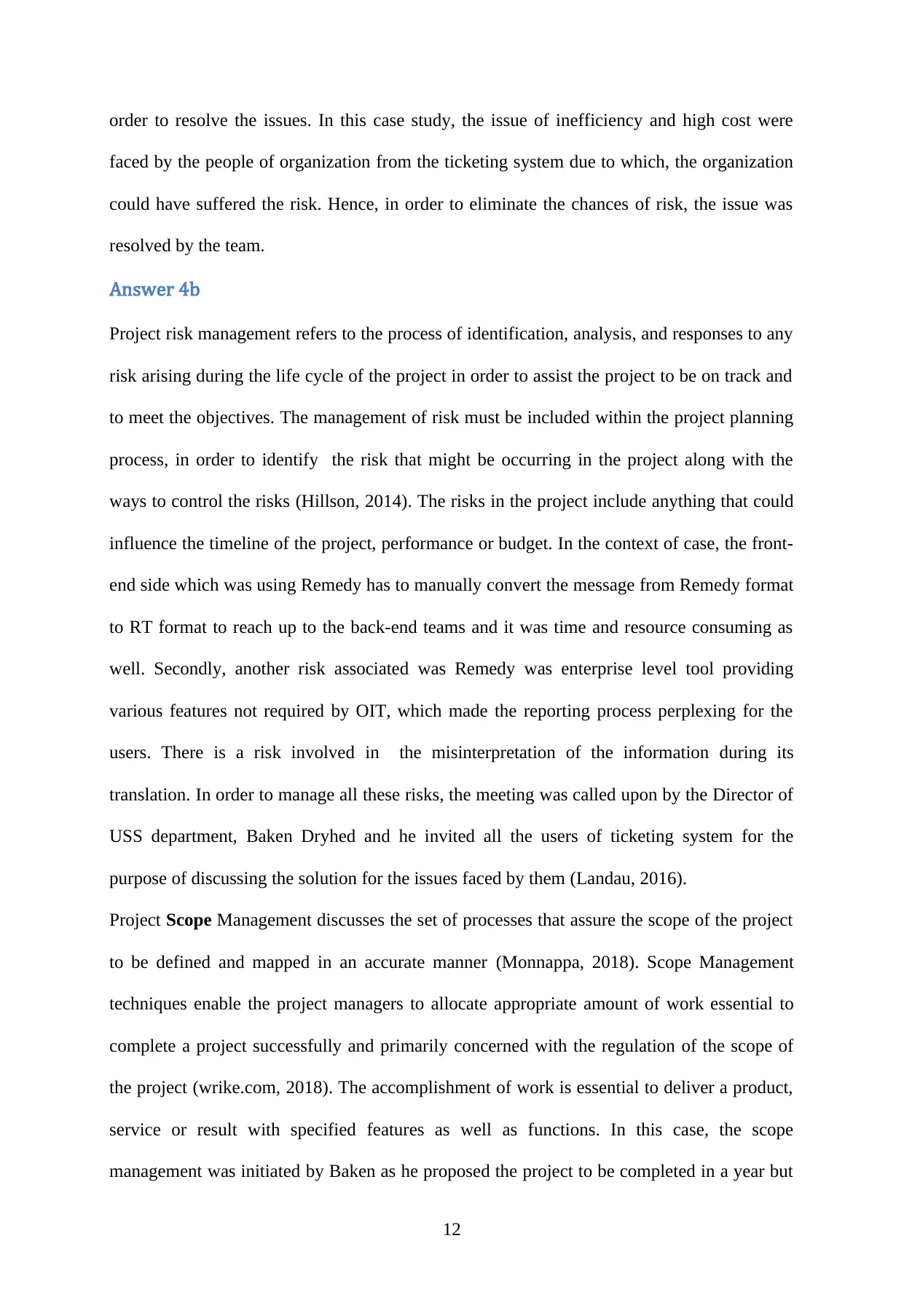
order to resolve the issues. In this case study, the issue of inefficiency and high cost were
faced by the people of organization from the ticketing system due to which, the organization
could have suffered the risk. Hence, in order to eliminate the chances of risk, the issue was
resolved by the team.
Answer 4b
Project risk management refers to the process of identification, analysis, and responses to any
risk arising during the life cycle of the project in order to assist the project to be on track and
to meet the objectives. The management of risk must be included within the project planning
process, in order to identify the risk that might be occurring in the project along with the
ways to control the risks (Hillson, 2014). The risks in the project include anything that could
influence the timeline of the project, performance or budget. In the context of case, the front-
end side which was using Remedy has to manually convert the message from Remedy format
to RT format to reach up to the back-end teams and it was time and resource consuming as
well. Secondly, another risk associated was Remedy was enterprise level tool providing
various features not required by OIT, which made the reporting process perplexing for the
users. There is a risk involved in the misinterpretation of the information during its
translation. In order to manage all these risks, the meeting was called upon by the Director of
USS department, Baken Dryhed and he invited all the users of ticketing system for the
purpose of discussing the solution for the issues faced by them (Landau, 2016).
Project Scope Management discusses the set of processes that assure the scope of the project
to be defined and mapped in an accurate manner (Monnappa, 2018). Scope Management
techniques enable the project managers to allocate appropriate amount of work essential to
complete a project successfully and primarily concerned with the regulation of the scope of
the project (wrike.com, 2018). The accomplishment of work is essential to deliver a product,
service or result with specified features as well as functions. In this case, the scope
management was initiated by Baken as he proposed the project to be completed in a year but
12
faced by the people of organization from the ticketing system due to which, the organization
could have suffered the risk. Hence, in order to eliminate the chances of risk, the issue was
resolved by the team.
Answer 4b
Project risk management refers to the process of identification, analysis, and responses to any
risk arising during the life cycle of the project in order to assist the project to be on track and
to meet the objectives. The management of risk must be included within the project planning
process, in order to identify the risk that might be occurring in the project along with the
ways to control the risks (Hillson, 2014). The risks in the project include anything that could
influence the timeline of the project, performance or budget. In the context of case, the front-
end side which was using Remedy has to manually convert the message from Remedy format
to RT format to reach up to the back-end teams and it was time and resource consuming as
well. Secondly, another risk associated was Remedy was enterprise level tool providing
various features not required by OIT, which made the reporting process perplexing for the
users. There is a risk involved in the misinterpretation of the information during its
translation. In order to manage all these risks, the meeting was called upon by the Director of
USS department, Baken Dryhed and he invited all the users of ticketing system for the
purpose of discussing the solution for the issues faced by them (Landau, 2016).
Project Scope Management discusses the set of processes that assure the scope of the project
to be defined and mapped in an accurate manner (Monnappa, 2018). Scope Management
techniques enable the project managers to allocate appropriate amount of work essential to
complete a project successfully and primarily concerned with the regulation of the scope of
the project (wrike.com, 2018). The accomplishment of work is essential to deliver a product,
service or result with specified features as well as functions. In this case, the scope
management was initiated by Baken as he proposed the project to be completed in a year but
12
⊘ This is a preview!⊘
Do you want full access?
Subscribe today to unlock all pages.

Trusted by 1+ million students worldwide
1 out of 16
Related Documents
Your All-in-One AI-Powered Toolkit for Academic Success.
+13062052269
info@desklib.com
Available 24*7 on WhatsApp / Email
![[object Object]](/_next/static/media/star-bottom.7253800d.svg)
Unlock your academic potential
Copyright © 2020–2025 A2Z Services. All Rights Reserved. Developed and managed by ZUCOL.





